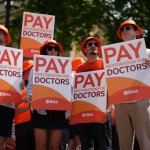When the UK prime minister, Boris Johnson, announced the reduction of social distancing from two metres to “one-metre plus”, he reassured the public that the decision was based on expert advice. He claimed that by adhering to a raft of “mitigating” measures – such as screens and partitions and using hand sanitiser – the overall risk of one metre will end up being “broadly equivalent” to the current level of risk at two metres.
Later the same day, during the government’s daily briefing, chief scientific adviser Patrick Vallance asserted that the risks under the new measures would be “equivalent” to the current level. He used the phrase “same risk” in response to a subsequent question. Chief medical adviser Chris Whitty spoke of the risks being “broadly similar” and “broadly equivalent”.
But can it really be true that the new package of measures will leave risk levels unchanged? It doesn’t seem credible – particularly since most of the mitigating measures have been known about for months and many are already in place alongside the two-metre rule.
If it really were true that these new arrangements can give the UK all the expected economic and social benefits without raising the risks, why weren’t they introduced weeks ago? That would surely have allowed all of us to reap the benefits much sooner while only facing “broadly equivalent” risks.
The most likely explanation is that the word “broadly” was being stretched to (or beyond) its limits and was being used as a cover for the lack of evidence – acknowledged in the background papers referenced above – that most of the mitigating measures have much effect. It is much more likely that the new arrangements will increase the risks. That will mean more illnesses, hospital admissions and deaths than if the country stuck to the restrictions currently in place.
This suggests that the government believes that those extra cases are a price worth paying for the economic and social benefits to be had. But Johnson and other ministers and advisers don’t want to say that up front because they feel uncomfortable about making those trade-offs explicit. Instead, they shelter behind the word “broadly” to give the impression that there is no serious downside in terms of risks.
But what if the truth is that the mitigating measures only partially offset the higher risk entailed by people getting closer to each other in more indoor situations – at work, in schools and colleges, in bars and restaurants, and at home. What might we expect?
A social dilemma
Let us start with the first three environments. Infection rates will go up. But for the great majority of people in those three settings, who are under 60 and reasonably fit with no underlying conditions, there will be a very low risk of death or a serious form of the illness. Many will be asymptomatic, while others will spend a week or two unwell at home. For all these millions, the risks of catching COVID will go up, but the consequences will mostly be minor and the benefits of getting back to something more like normal life will be substantial.
However, because there will be more infections in the community, many of which will be undetected, elderly people and those with various existing health conditions will – especially when spending time with friends and younger relatives in their homes – be more likely to be infected. A greater proportion of them are more likely to become seriously ill, requiring hospitalisation. And they are more likely to die.
That is the likely reality and it should not be “broadly” brushed over. Instead, those who claim the roles of leadership and authority should state the social dilemma clearly and honestly. On the one side, tens of millions of younger, healthier citizens will benefit from fewer job losses, restored incomes, resumed education and training and partial restoration of social life. On the other side, hundreds of thousands of people with underlying health problems and/or fewer remaining years of life will suffer disproportionately. Hundreds – possibly thousands – will have their lives shortened by months or years. How do we balance those things against one another?
Trade-offs
The fact is that trade-offs between health and wealth are being made all the time, by all of us in our private lives as well as by public sector bodies. Perhaps most relevant to the COVID situation is that the UK Department of Health and Social Care says that if some treatment can give an average patient extra quality and length of life equivalent to a year in full health – that is, a quality adjusted life year (QALY) – it is worth up to £60,000 of taxpayers’ money.
If that figure were applied to the changes in the restrictions, every 10,000 QALYs lost due to the extra illnesses and earlier deaths resulting from the new measures would require the economic benefits from changing the rules to add up to at least £600 million.
Those are the kinds of trade-offs involved in decisions about easing the lockdown. Citizens are entitled to be given the best possible estimates of the true figures and be told what values the government is using to underpin its decisions. And they are entitled to make a properly informed judgement about whether the right values are being used and whether the appropriate balance is being struck between the gains and losses involved. Overworking the word “broadly” to fudge the issue is not what we should expect of our government and its advisers.
Graham Loomes has received funding from the Economic and Social Research Council and from the Leverhulme Trust, but neither organisation is funding this article. He is a member of the Labour Party.










